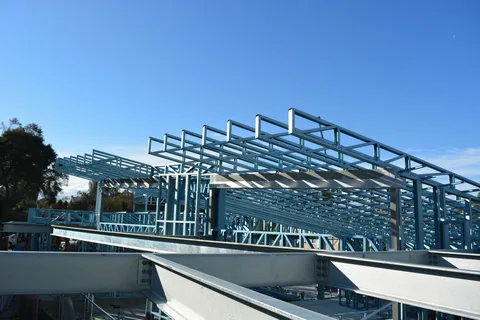In the realm of construction and business, the fusion of kit building and commercial units has opened new avenues for innovation and efficiency. This article delves into the intricacies of kit building for commercial units, exploring its benefits, challenges, and best practices.
Understanding Kit Building
Kit building, also known as prefabrication, involves the manufacture of building components off-site and their assembly at the final location. This method offers several advantages, including cost savings, faster construction timelines, and improved quality control.
Benefits of Kit Building
- Cost Efficiency: Prefabricated components are often more cost-effective than traditional construction methods due to streamlined manufacturing processes and bulk purchasing of materials.
- Time Savings: Kit building significantly reduces construction time, enabling businesses to expedite project completion and start generating revenue sooner.
- Quality Control: Manufacturing building components in a controlled environment enhances quality assurance and minimizes errors during assembly.
Integrating Kit Building with Commercial Units
Commercial units encompass a wide range of establishments, including offices, retail spaces, and industrial facilities. Incorporating kit building techniques into commercial construction projects offers numerous benefits tailored to the specific needs of businesses.
Customization Options
While prefabricated components offer standardization, they can also be customized to suit the unique requirements of commercial units. Architects and designers can collaborate with manufacturers to create bespoke solutions that align with branding, functionality, and aesthetic preferences.
Scalability and Flexibility
Kit building facilitates scalability, allowing businesses to expand or modify their commercial units with ease. Whether it’s adding extra office space or reconfiguring retail layouts, prefabricated components offer flexibility to adapt to evolving business needs.
Sustainability Considerations
The environmental impact of construction is a growing concern for businesses and communities alike. Kit building promotes sustainability through efficient use of materials, reduced waste generation, and opportunities for energy-efficient design integration.
Overcoming Challenges
While kit building offers numerous advantages, it’s not without its challenges. Addressing these hurdles is essential to maximize the benefits of prefabrication in commercial unit construction.
Logistics and Transportation
Transporting prefabricated components to the construction site requires careful planning to minimize costs and ensure timely delivery. Coordination between manufacturers, logistics providers, and on-site teams is crucial to streamline this process effectively.
Regulatory Compliance
Compliance with building codes and regulations is essential for any construction project. Prefabricated components must meet stringent standards to ensure structural integrity, safety, and durability, necessitating close collaboration between manufacturers and regulatory authorities.
Embracing Technology in Construction
In recent years, technological advancements have revolutionized the construction industry, offering innovative solutions to enhance efficiency and productivity. Kit building, combined with cutting-edge technologies such as Building Information Modeling (BIM) and modular construction, further amplifies the benefits of prefabrication in commercial unit development.
Building Information Modeling (BIM)
BIM facilitates collaborative design and construction processes by creating digital representations of buildings and infrastructure. By utilizing BIM software, architects, engineers, and contractors can visualize the entire project lifecycle, from conceptualization to maintenance, thereby optimizing decision-making and reducing errors.
Modular Construction
Modular construction involves the fabrication of entire building modules off-site, which are then transported and assembled on-site. This approach offers enhanced precision, quality control, and construction speed, making it well-suited for commercial unit development.
Augmented Reality (AR) and Virtual Reality (VR)
AR and VR technologies enable stakeholders to visualize and interact with virtual representations of construction projects. These immersive experiences facilitate design review, stakeholder engagement, and on-site training, enhancing communication and collaboration throughout the construction process.
Future Trends and Innovations
As the construction industry continues to evolve, several emerging trends and innovations are shaping the future of kit building and commercial unit development.
Sustainable Materials and Practices
The demand for sustainable construction materials and practices is driving innovation in eco-friendly building solutions. From recycled materials to energy-efficient designs, businesses are prioritizing sustainability to minimize environmental impact and meet regulatory requirements.
Off-Site Manufacturing Facilities
The establishment of off-site manufacturing facilities, also known as “construction factories,” is gaining traction as a cost-effective and scalable approach to kit building. These facilities leverage automation, robotics, and advanced manufacturing techniques to produce prefabricated components with precision and efficiency.
Smart Buildings and IoT Integration
The integration of Internet of Things (IoT) devices and sensors into commercial units enables real-time monitoring, control, and optimization of building systems. From smart lighting and HVAC to security and occupancy management, IoT technology enhances operational efficiency, occupant comfort, and sustainability.
FAQ
Q: What types of commercial units are suitable for kit building?
A: Kit building can be adapted to various commercial applications, including offices, retail stores, restaurants, healthcare facilities, and educational institutions.
Q: How does kit building impact project timelines?
A: Kit building typically accelerates project timelines by up to 50% compared to traditional construction methods, enabling businesses to open their commercial units sooner and generate revenue faster.
Q: Are there limitations to customization with prefabricated components?
A: While prefabricated components offer standardized solutions, they can be customized to meet specific design requirements, ensuring that commercial units reflect the branding and functionality desired by businesses.
Conclusion
Kit building presents a compelling opportunity for businesses seeking efficient, cost-effective solutions for commercial unit construction. By leveraging prefabrication techniques, businesses can streamline the building process, enhance flexibility, and achieve sustainable outcomes. Embracing innovation in construction practices is key to staying competitive in today’s dynamic business landscape.
